Rirkrit Tiravanija
DAS GLÜCK IST NICHT IMMER LUSTIG
12 Sep 2024 - 12 Jan 2025
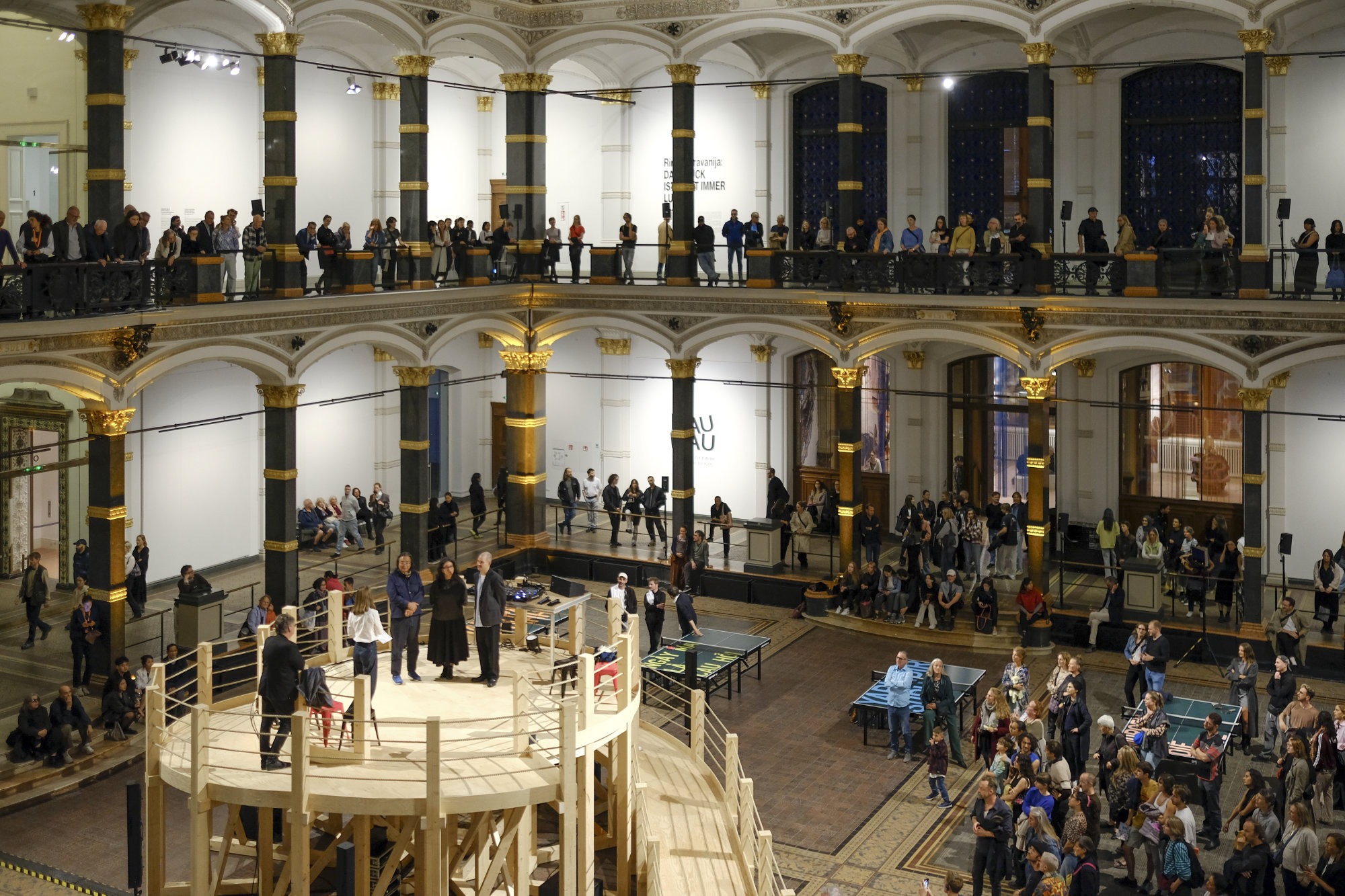
Rirkrit Tiravanija, untitled 2024 (demo station no. 8), 2024, installation view, Rirkrit Tiravanija: DAS GLÜCK IST NICHT IMMER LUSTIG, Gropius Bau, 2024
© Gropius Bau, photo: Guannan Li
© Gropius Bau, photo: Guannan Li
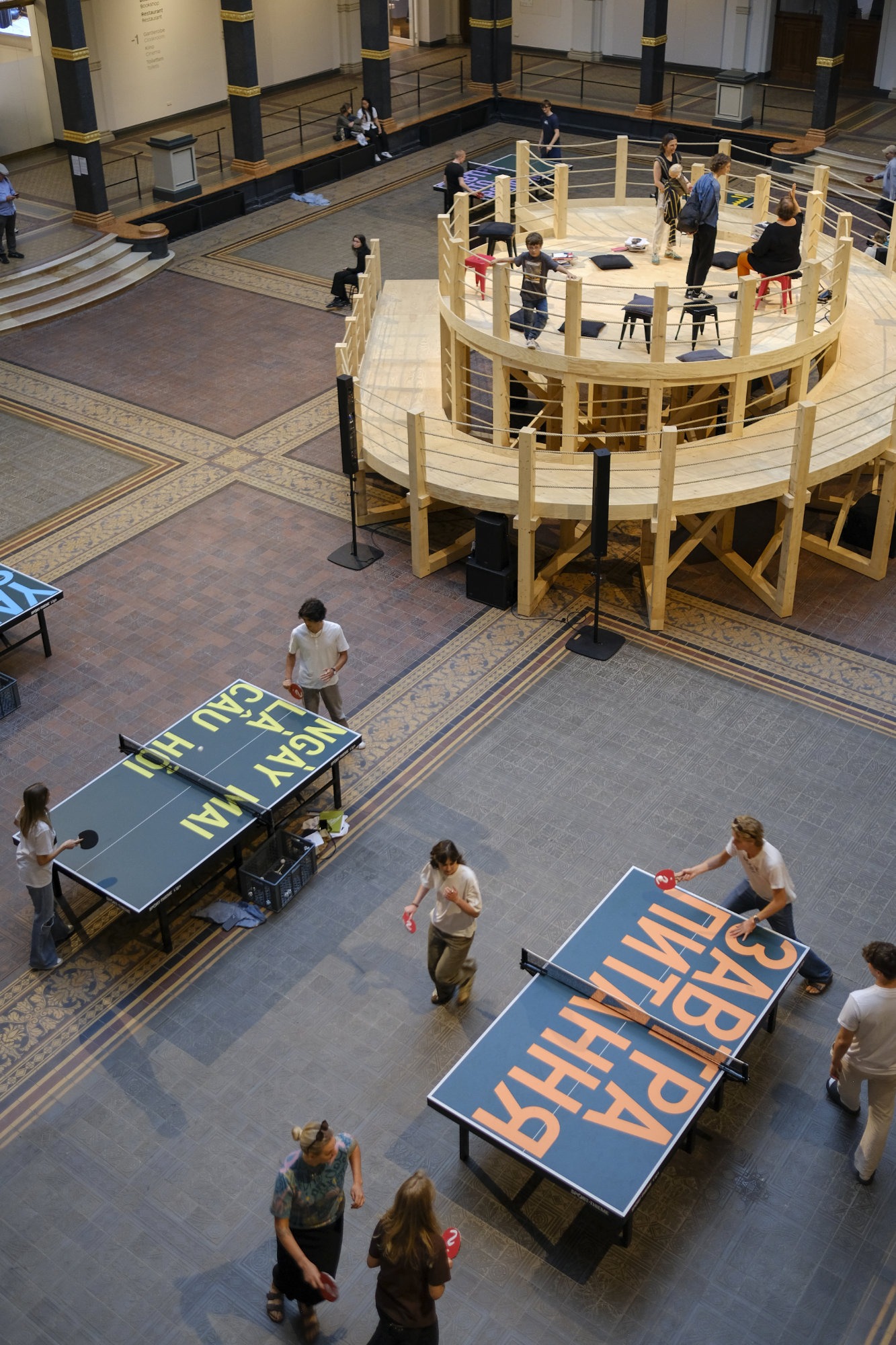
Rirkrit Tiravanija, untitled 2024 (demo station no. 8), 2024, installation view, Rirkrit Tiravanija: DAS GLÜCK IST NICHT IMMER LUSTIG, Gropius Bau, 2024
© Gropius Bau, photo: Guannan Li
© Gropius Bau, photo: Guannan Li
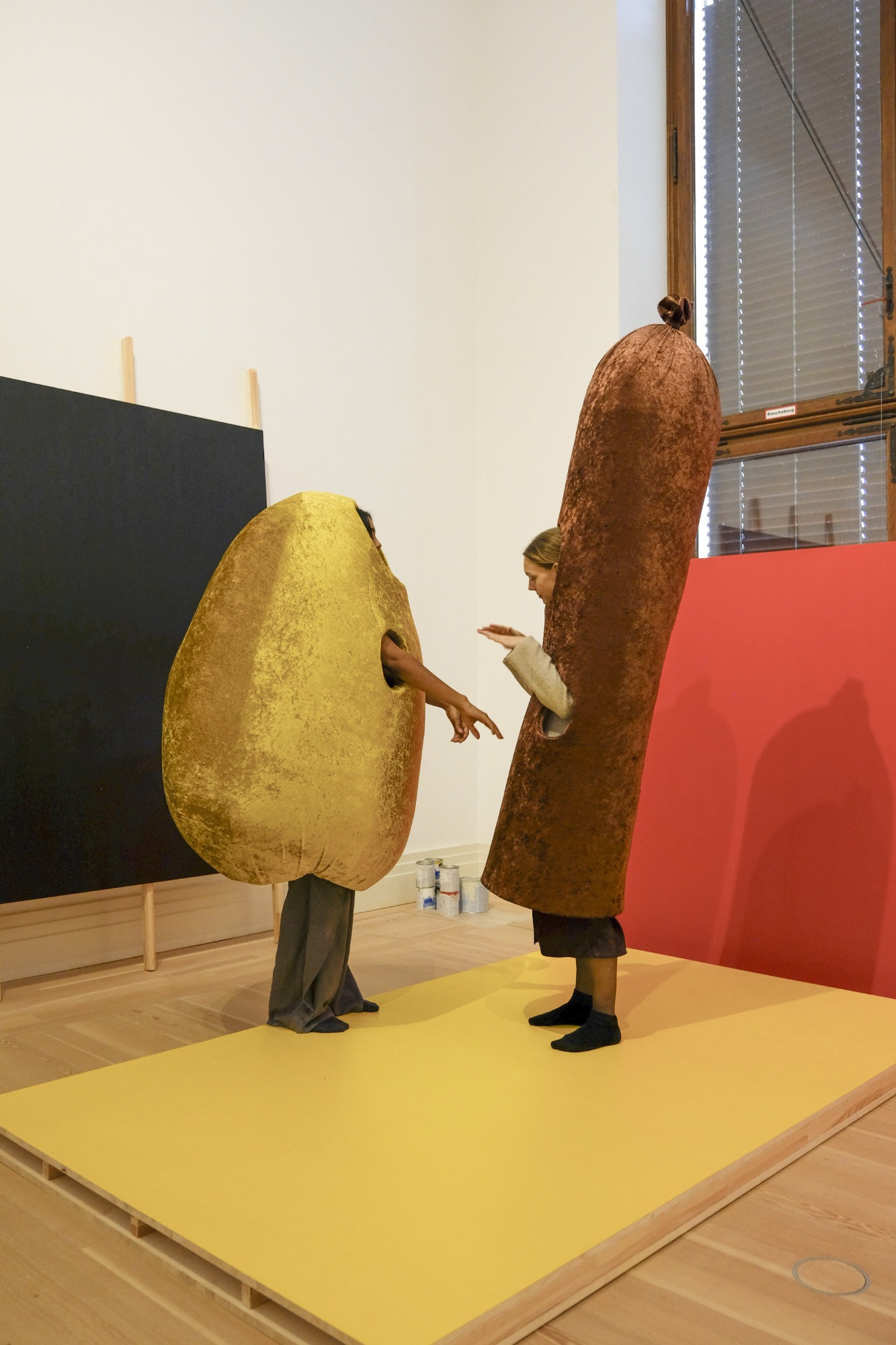
Rirkrit Tiravanija, untitled 1997 (a demonstration by faust as a sausage and franz biberkopf as a potato), 1997, installation view, Rirkrit Tiravanija: DAS GLÜCK IST NICHT IMMER LUSTIG, Gropius Bau, 2024
© Gropius Bau, photo: Guannan Li
© Gropius Bau, photo: Guannan Li
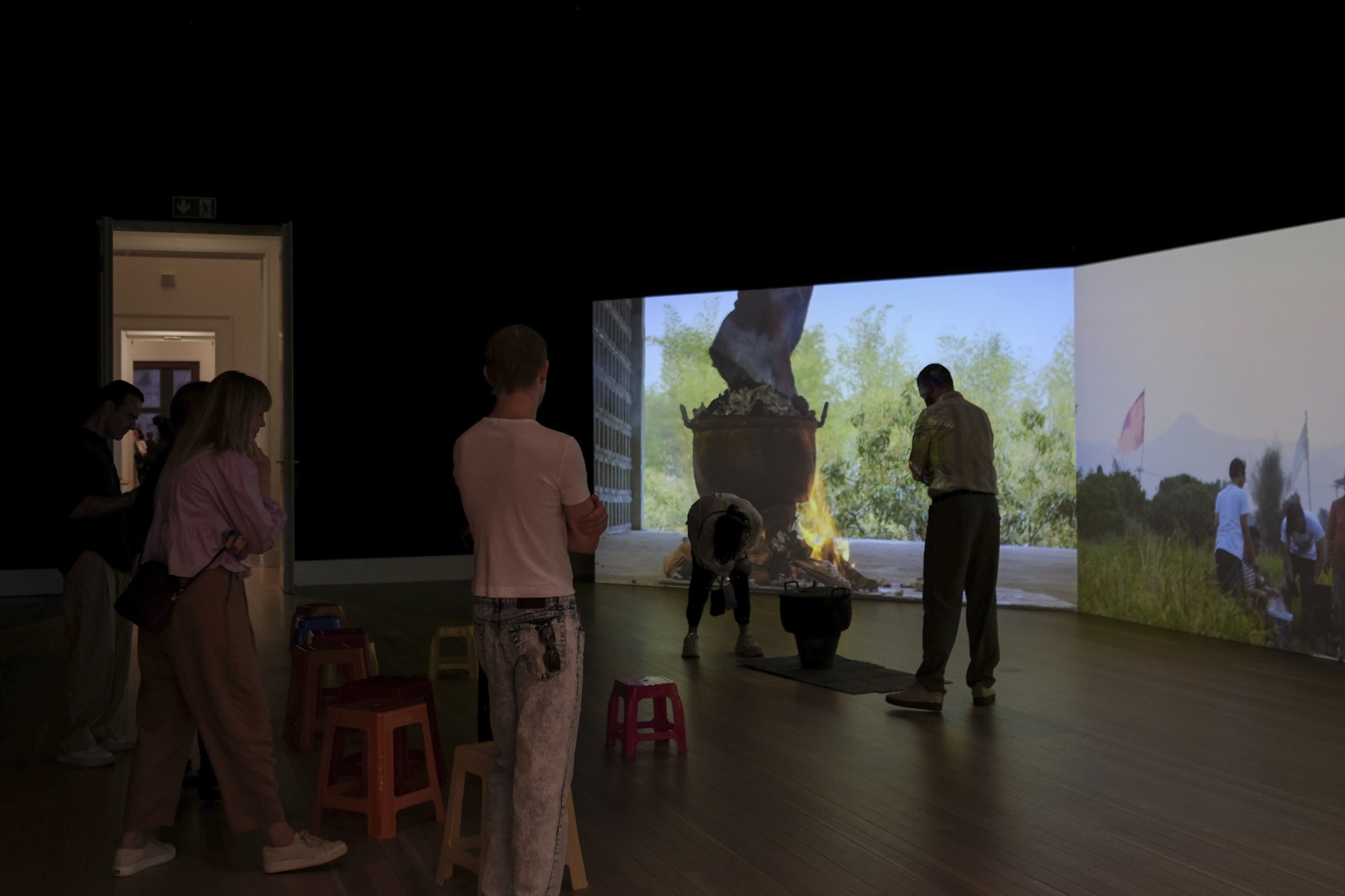
Rirkrit Tiravanija, untitled 2014-2016 (curry for the soul of the forgotten), 2014-2016, installation view, Rirkrit Tiravanija: DAS GLÜCK IST NICHT IMMER LUSTIG, Gropius Bau, 2024
© Gropius Bau, photo: Guannan Li
© Gropius Bau, photo: Guannan Li
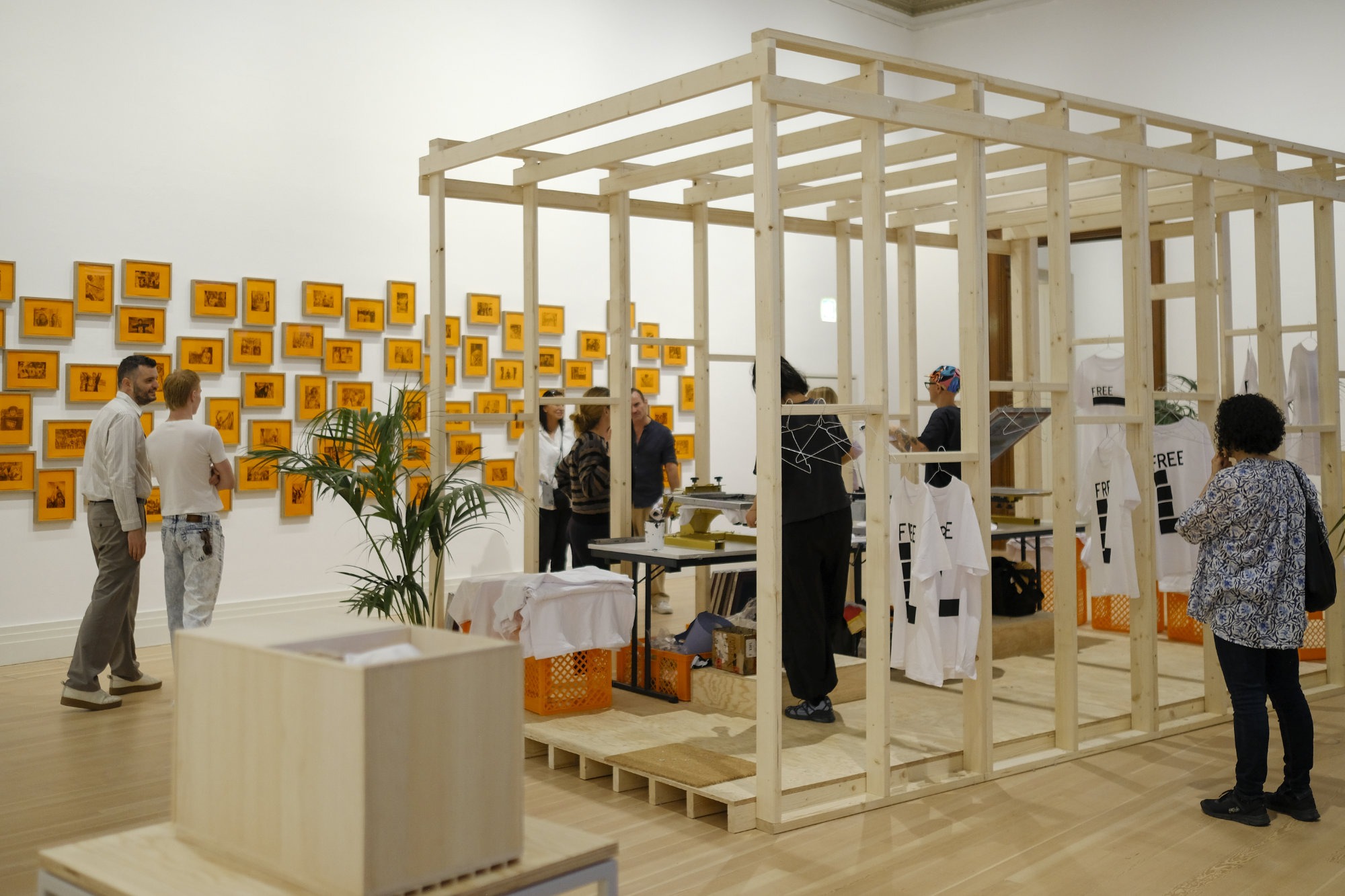
Rirkrit Tiravanija, untitled 2022 (chance will never abolish), 2022, installation view, Rirkrit Tiravanija: DAS GLÜCK IST NICHT IMMER LUSTIG, Gropius Bau, 2024
© Gropius Bau, photo: Guannan Li
© Gropius Bau, photo: Guannan Li
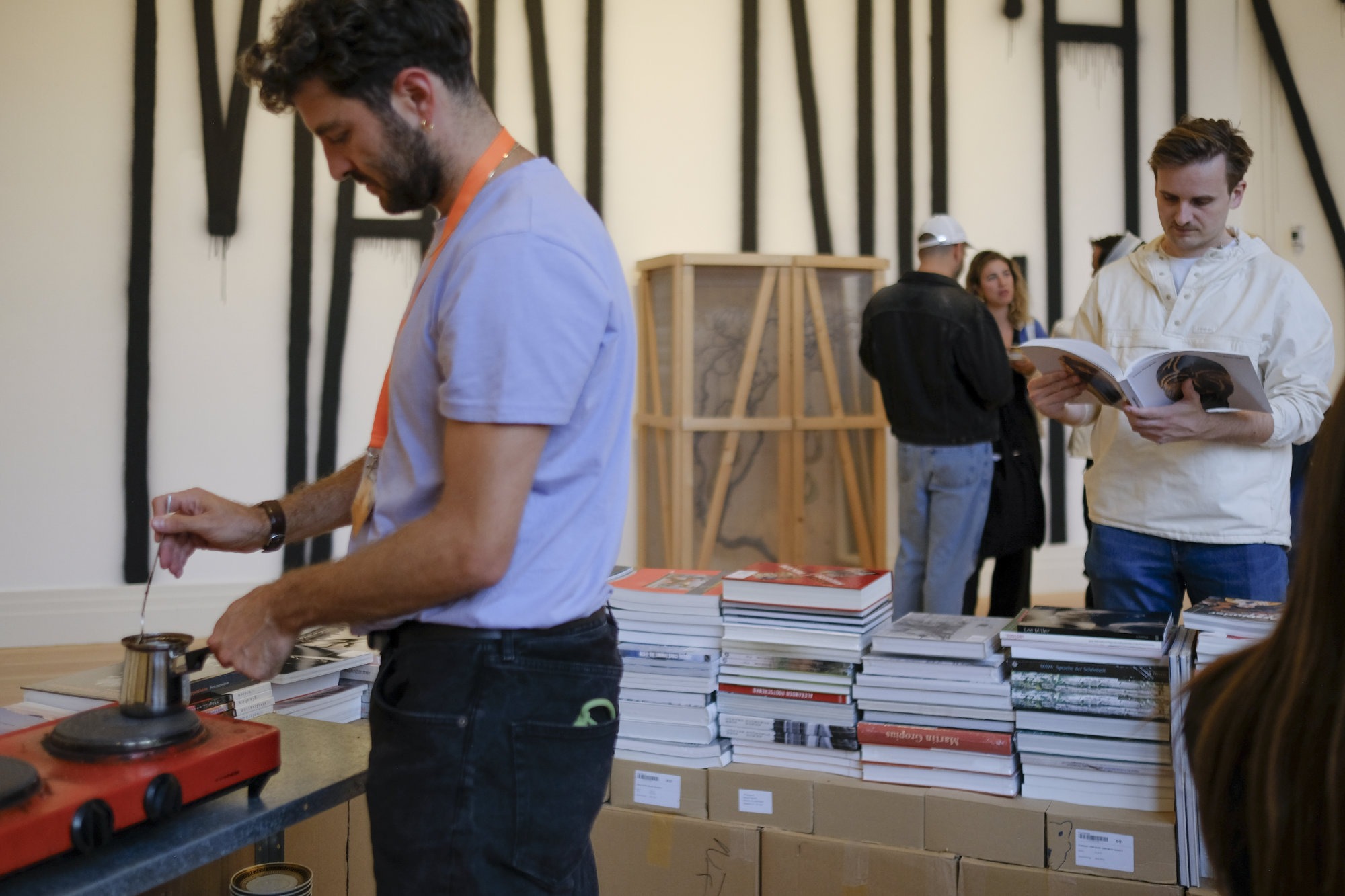
Rirkrit Tiravanija, untitled 1993 (café deutschland), 1993, installation view, Rirkrit Tiravanija: DAS GLÜCK IST NICHT IMMER LUSTIG, Gropius Bau, 2024
© Gropius Bau, photo: Guannan Li
© Gropius Bau, photo: Guannan Li
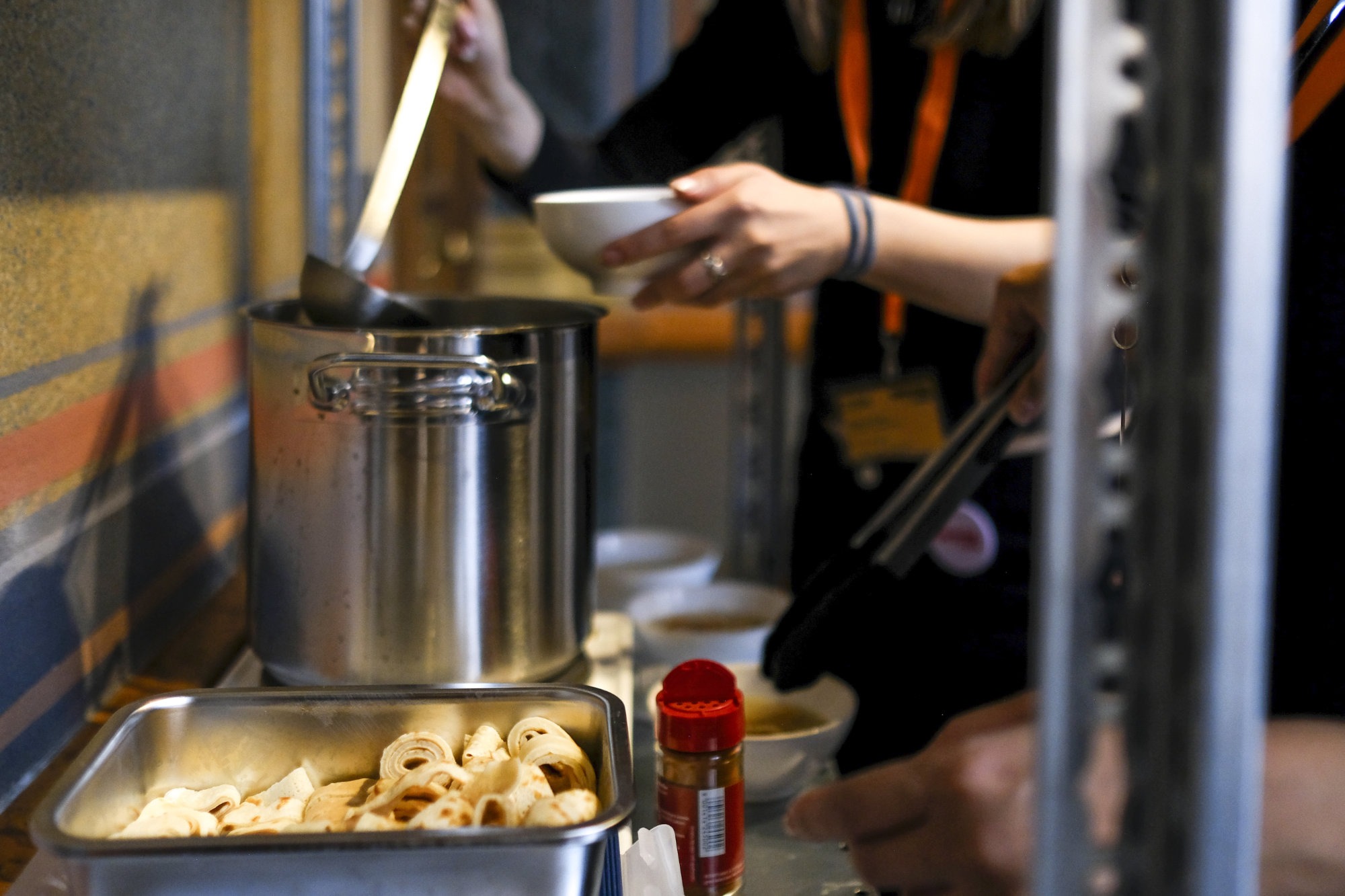
Rirkrit Tiravanija, untitled 1993 (flädlesuppe), 1993, detail, Rirkrit Tiravanija: DAS GLÜCK IST NICHT IMMER LUSTIG, Gropius Bau, 2024
© Gropius Bau, photo: Guannan Li
© Gropius Bau, photo: Guannan Li
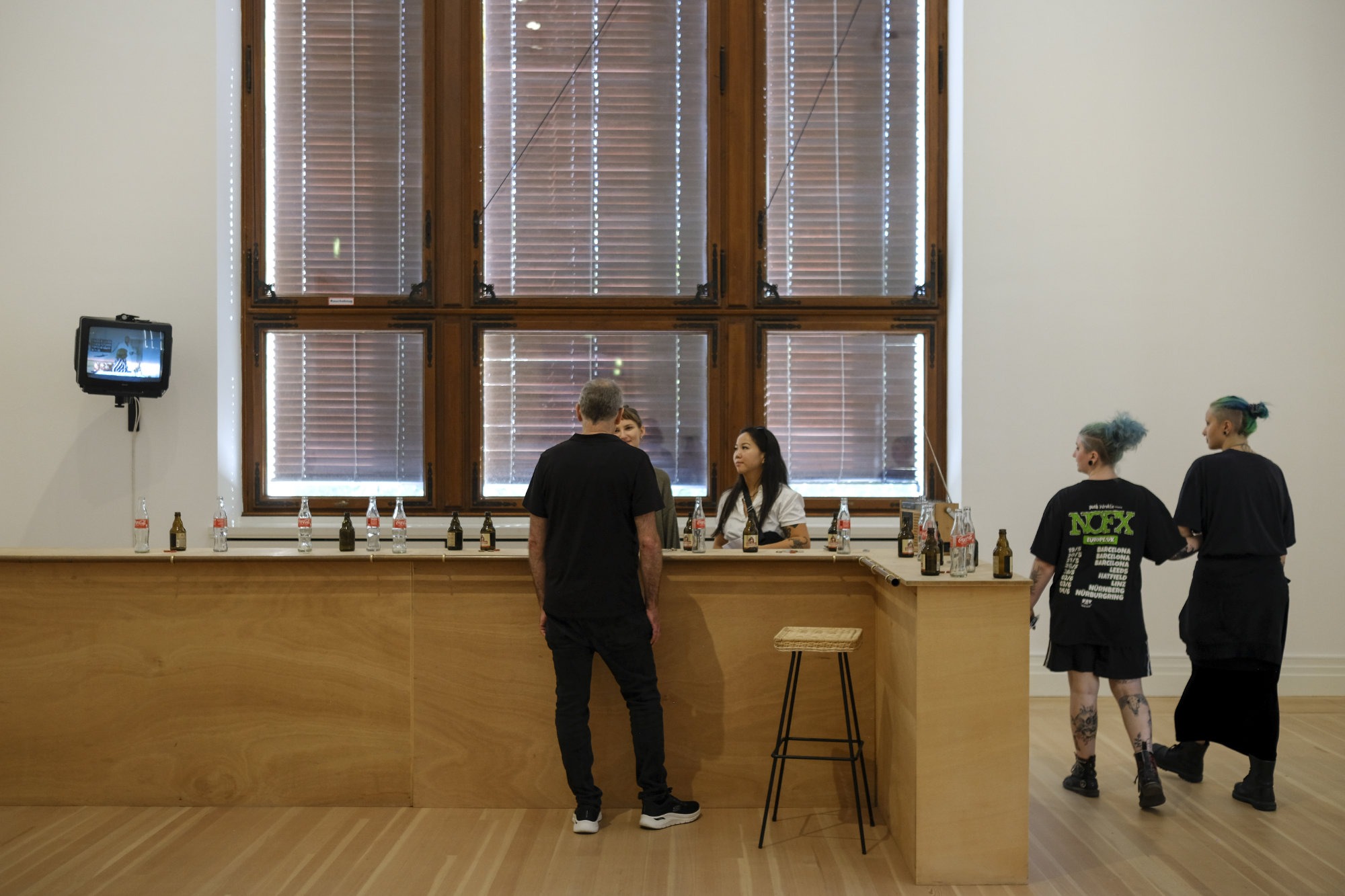
Rirkrit Tiravanija, untitled 1994 (angst essen seele auf), 1994, installation view, Rirkrit Tiravanija: DAS GLÜCK IST NICHT IMMER LUSTIG, Gropius Bau, 2024
© Gropius Bau, photo: Guannan Li
© Gropius Bau, photo: Guannan Li
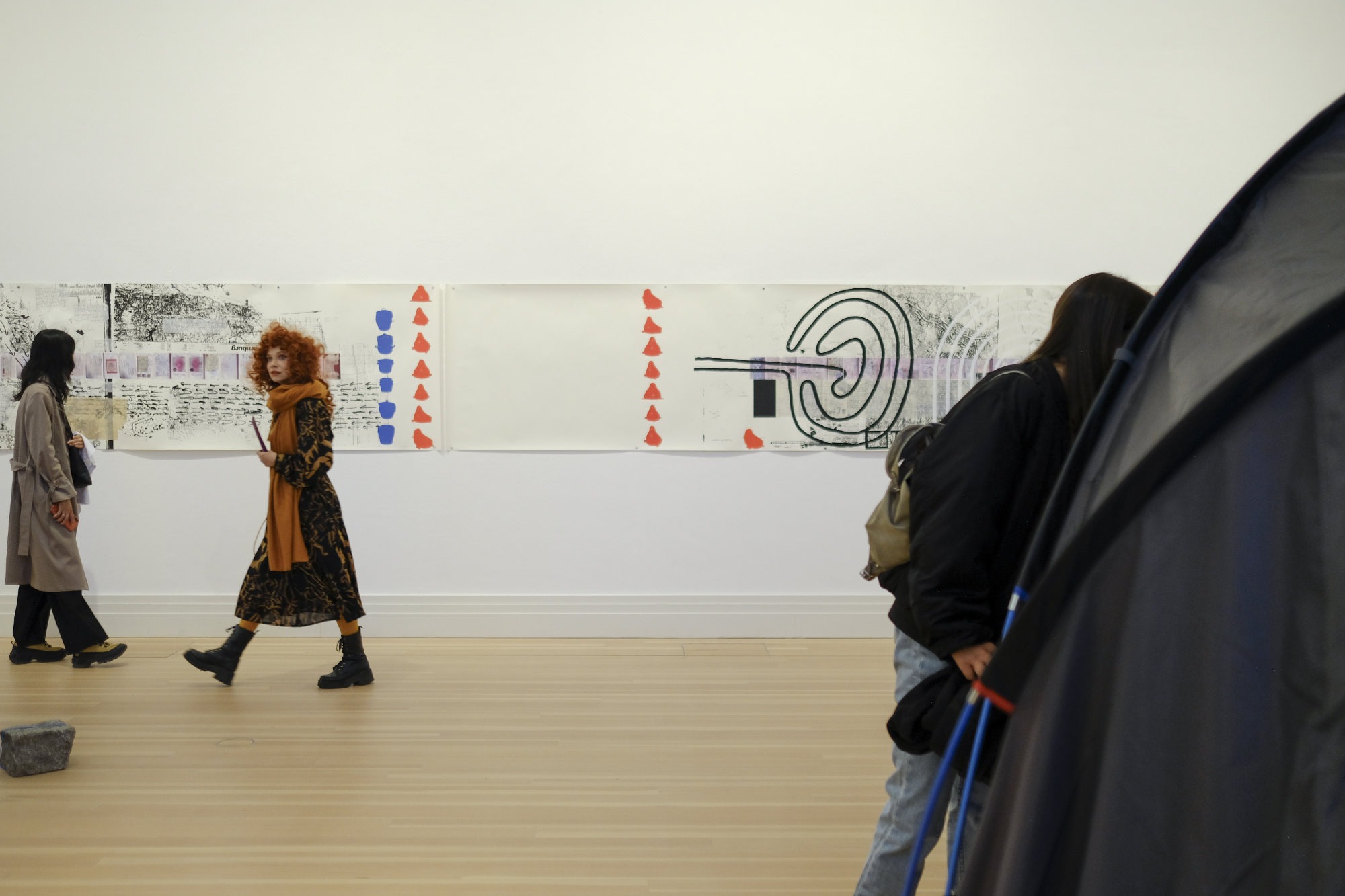
Rirkrit Tiravanija, untitled 2008-2011 (the map of the land of feeling), 2008-2011, installation view, Rirkrit Tiravanija: DAS GLÜCK IST NICHT IMMER LUSTIG, Gropius Bau, 2024
© Gropius Bau, photo: Guannan Li
© Gropius Bau, photo: Guannan Li
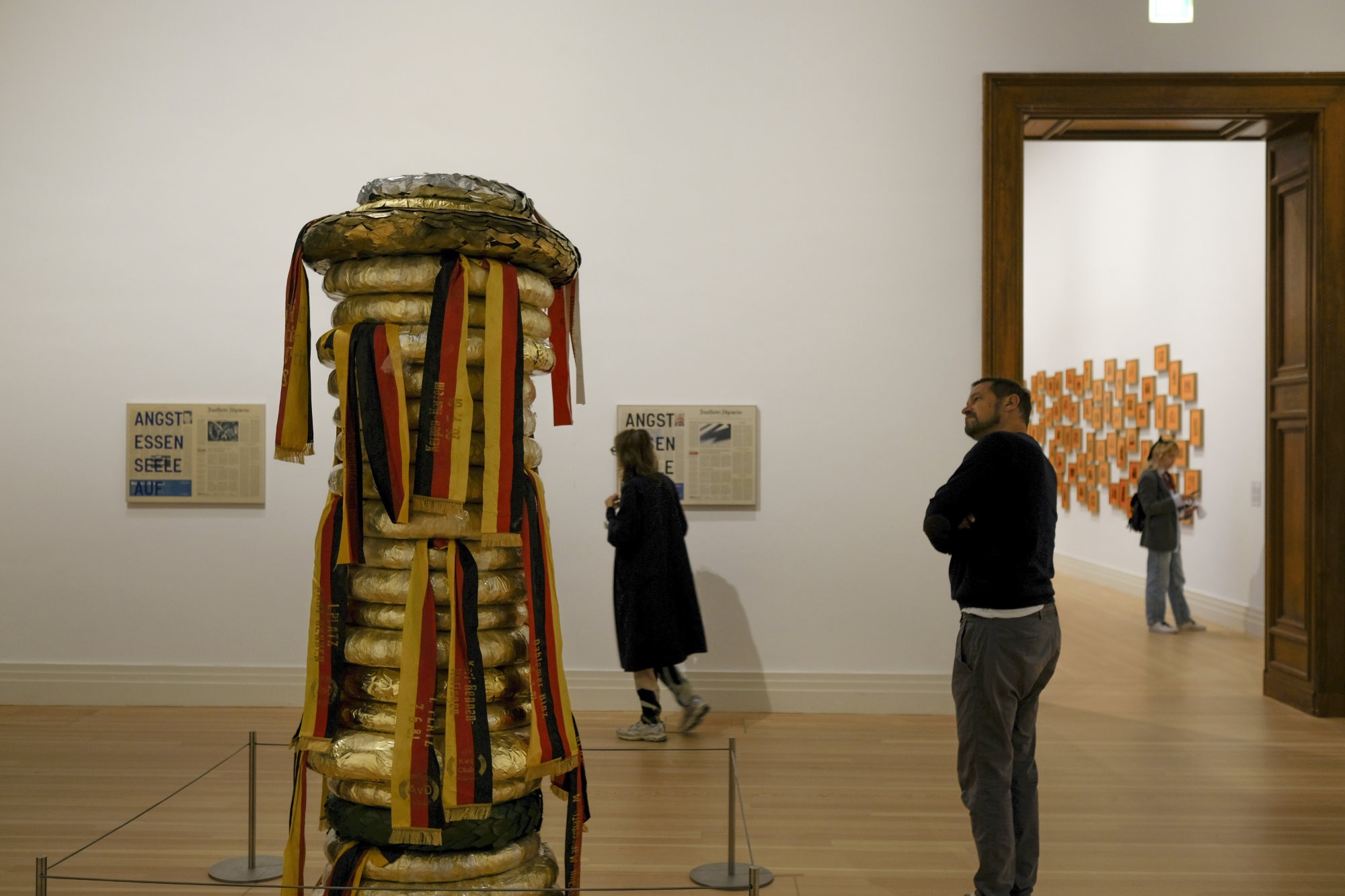
Rirkrit Tiravanija, untitled 2001 (siegerkranzstapel), 2001, installation view, Rirkrit Tiravanija: DAS GLÜCK IST NICHT IMMER LUSTIG, Gropius Bau, 2024
© Gropius Bau, photo: Guannan Li
© Gropius Bau, photo: Guannan Li
The artist Rirkrit Tiravanija has a connection with Germany, and especially with Berlin, that goes back more than 30 years. Rirkrit Tiravanija: DAS GLÜCK IST NICHT IMMER LUSTIG at the Gropius Bau is the first major exhibition to take a closer look at this relationship.
Tiravanija’s artistic engagement with Germany, Western exhibition practice and the lived reality and everyday experiences of migrants is full of references to art history and film, offering critical, humorous and participative access to current debates within society.
His work expands conventional definitions of art and creates situations in which social structures and interactions can take shape. The explosive force of Tiravanija’s art lies in his practice of shifting institutional boundaries and opening categories – there’s cooking and eating, there’s music making and play; things get loud, things get lively. DAS GLÜCK IST NICHT IMMER LUSTIG is not a traditional retrospective focusing on the contemplation of artworks, instead offering visitors a constantly changing art experience for the senses. The exhibition takes its title from the opening sequence of Rainer Werner Fassbinder’s Angst essen Seele auf (Ali: Fear Eats the Soul, 1974). Today, 50 years after its release, with deepening social divisions and the rise of far-right political parties, the film is shockingly relevant. For Tiravanija, Fassbinder’s work is an important reference that he has worked with repeatedly, in various formats.
DAS GLÜCK IST NICHT IMMER LUSTIG brings together more than 80 works made between 1987 and 2024 in cities including Chicago, New York, Cologne, Berlin, Mönchengladbach, Zürich and Chiang Mai, ranging from early installations based on institutional critique, to experimental 8mm films and photographs, to text-based paintings and regular activations of the participatory works with which the artist came to prominence.
In the atrium at the Gropius Bau, untitled 2024 (demo station no. 8), a replica of Friedrich Kiesler’s spiral stage, provides a space for public performances, daily from 15:00. Alongside the stage, untitled 2024 (tomorrow is the question), consisting of eight ping-pong tables, invites visitors to play with friends and strangers. In this way, the admission-free atrium becomes a place where different people can come together and spend time amid flying ping-pong balls, cavorting children and performances. In the exhibition, musicians can use the installation untitled1996 (rehearsal studio) free of charge for band rehearsals, concerts and recording sessions.
On alternate days, from 13:00 to 14:00, visitors will be treated to Tiravanija’s free food actions untitled 1991 (tom ka soup) and untitled 1993 (flädlesuppe) in cooperation with cooks from Berlin’s Thai Park. In untitled 2024 (chance will never abolish), visitors can have T-shirts (provided) screen-printed with Tiravanija’s slogans every Monday and Thursday. A series of screenings in the Gropius Bau’s cinema explores the artist’s collaborative filmmaking practices.
“A year after my arrival at the Gropius Bau, we begin the autumn programme with an exhibition by Rirkrit Tiravanija, whose artistic practice anticipates what we are planning for the years to come. His performative and interdisciplinary formats facilitate playful encounters with art activating all senses. We want our audiences to smell, taste, touch, see and hear. Laughing, playing, debating, thinking, dancing – all of these sensations and forms of expression can coexist in the exhibition space. In the future, the transformative abilities of the artists with whom we work will play an even more central role at the Gropius Bau, helping to create a place of exchange and collective experience – a place that speaks to a broad public.”
— Jenny Schlenzka, Director of the Gropius Bau
Freedom cannot be simulated
Tiravanija’s close relationship with Germany began in 1993 with group exhibitions at Galerie Max Hetzler in Cologne and at Hamburger Kunstverein. In 1998, as an up-and-coming artist travelling between international biennials, he spent time living in Berlin, where he has an apartment and his archive to this day. This puts him among a generation of international artists who discovered the German capital as a place to work after the fall of the Berlin Wall. Since then, he has regularly developed works that deal with the political and cultural specificities of the country. DAS GLÜCK IST NICHT IMMER LUSTIG brings together works from this period and points to the ongoing importance of Germany as a site of inspiration and artistic production.
The first time Tiravanija planned to visit Germany, however, he was unable to obtain a visa: in 1993, having accepted an invitation to participate in a group exhibition in Cologne, his unresolved residency status in the United States denied him to travel to Germany, forcing him to realise his work by faxing instructions to the gallery.
This work address the experience of so-called guest workers in post-Wall Germany: a few weeks before the exhibition opening, a deadly racist arson attack on Turkish people in Mölln and the demonstrations it provoked had made headlines, even in the United States. In the context of these events, he developed untitled 1993 (café deutschland): an installation made using exhibition catalogues, a table, four chairs, flowers and everything required to make Turkish coffee, inviting visitors every day to sit down together and talk over a hot drink. Instructions on the wall provide the recipe – a recurring element in Tiravanija’s oeuvre. The title refers to Jörg Immendorff’s Café Deutschland (1977–1982), a series of paintings on the Cold War and the division of Germany.
“I am not interested in leaving (any)things behind; I am interested in leaving ideas behind. Like a good recipe, everyone knows what it is, what it tastes like and even how to make it again – perhaps even differently, following their own interpretation; or perhaps it would be a base for something completely different, a possibility.”
— Rirkrit Tiravanija
With its use of water, coffee, cardamom and (optionally) sugar, this work is one of the first in which Tiravanija used ingredients not linked to Thai culture.
Curry for the soul
On encountering Tiravanija’s works, one might first notice the smell of chilli peppers or fish sauce or, as in the case of untitled 1993 (café deutschland), freshly brewed Turkish coffee, before one sees the work itself. There are many anecdotes about the artist’s early cooking performances; in 1989, he first exhibited a simmering curry on a plinth and then, a year later, he served Pad Thai at the opening of his first solo show in New York – with some visitors mistaking him for the caterer.
These works resulted among others from an in-depth engagement with the collecting and exhibiting practice of Western museums and the underlying systems of thought in art history, archeology and ethnology. During visits to museums, Tiravanija would keep coming across historical artifacts like Buddha statues, bowls and other vessels he was familiar with from Thai culture, and he was bothered by the fact that these everyday items were exhibited as isolated objects on plinths or in vitrines, detached from their cultural context and ordinary usage. As a young artist, he first showed what he saw as the alternative to this: “take the pot out of the vitrine and cook in it.” His idea of “cultural retrieval”, developed at the end of the 1980s, involved bringing objects from art and ethnographic collections back into life, allowing them to be experienced as an integral part of cultural contexts; this was both a critique and an invitation to think about the cultural significance and social function of these objects.
The social and political dimension of preparing and eating food plays an important role in Tiravanija’s work, and it also has a biographical background:
“I grew up around the kitchen of my grandmother, who was a well-known teacher of both Thai and Continental cuisine; besides teaching, she had her own restaurant and her own television show. This became a significant factor in my development as an artist. I learned the arts of sharing and giving. [...] In my work of the last ten years, I have become known as the ‘cook’ of the art world. I have, more or less, used the kitchen and cooking as the base from which to conduct an assault on the cultural aesthetics of Western attitudes toward life and living. I have found food to be a common medium for creating conditions and experiences for communicating that does not always entail language but has a spiritual dimension. In the communal act of cooking and eating together, I hope that it is possible to cross physical and imaginary boundaries.” — Rirkrit Tiravanija
The often very ordinary arrangements – gas stoves or electric woks, a makeshift table, ingredients, and “lots of people” – invite the audience to question the dividing line between art and everyday life by taking part.
The map of the land of feeling
“I have always been traveling, it is about change, and about shift, it’s about moving in order to remember that one is living.”
— Rirkrit Tiravanija
Another central theme in Tiravanija’s work is travel, and “being on the road” as a state of mind that has shaped his artistic practice. In the 1990s he turned to the theme of the artist’s journey, a leitmotif in Western art and literature. With his own journeys, he reversed the gaze of the paradox of cultural voyeurism reproduced by modern art, ethnology and tourism. For untitled 1995 (bon voyage monsieur ackermann), Tiravanija and German artist Franz Ackermann drove a converted yellow Opel Commodore from Berlin to Lyon, where they exhibited the car together with videos documenting their trip at the Lyon Biennale – an artist’s journey in which Europe itself became the Other.
The ethnological or touristic gaze is also addressed by Tiravanija in works like untitled 1992 (consumed) and untitled 1993 (rucksack installation) in which he reinterpreted the related practices of mapmaking, photography and filmmaking, using them not to order and fix reality, but to make new connections and new meanings.
Tomorrow is the question
A pronounced interest in social interaction is a running thread through the whole of Tiravanija’s oeuvre, with many of his works realised only when people activate them.
This is especially true of the “Demo Stations” he has been making since 2001: platforms on which a large range of presentations and performances can take place, such as cooking battles, origami workshops or scientific lectures. The version at the Gropius Bau, untitled 2024 (demo station no. 8), is a spiral structure that refers to Friedrich Kiesler’s Raumbühne (1924) and to Tiravanija’s interest in staging and theatricality. This exposed stage is juxtaposed with a work that proposes a more horizontal kind of communication and connection: untitled 2024 (tomorrow is the question) consists of eight ping-pong tables that can be used by everyone during the exhibition’s opening hours.
Biography
“All work that I have ever made is about the position I am in, in the Western world, which I was trying to understand.” — Rirkrit Tiravanija
Rirkrit Tiravanija (born 1961 in Buenos Aires) is one of the world’s most influential artists working across multiple disciplines. He grew up in a Thai diplomatic family, living in various cities including Buenos Aires, Bangkok, Addis Ababa and Toronto, before enrolling at the Ontario College of Art in Ottawa, Canada. In 1984 he moved to the United States to study at the School of the Art Institute of Chicago and later at the Whitney Museum of American Art Independent Study Program (ISP) in New York. He made his first installations in the mid-1980s. Integrating communal activities such as conversation, music and games, drinking and cooking with visitors, Tiravanija gained recognition by transforming exhibitions into social situations in which he explicitly formulated a critique, questioning portrayals of Asian art and racist stereotypes within the ideological constructs of Western hegemonic culture. Tiravanija lives in New York, Berlin and Chiang Mai.
The title of the exhibition, DAS GLÜCK IST NICHT IMMER LUSTIG, quotes the text reference from the opening credits of the film Angst essen Seele auf (1974) © Rainer Werner Fassbinder Foundation.
Curated by Jenny Schlenzka, Director, Gropius Bau, Yasmil Raymond, Independent Curator, and Christopher Wierling, Assistant Curator, Gropius Bau
Tiravanija’s artistic engagement with Germany, Western exhibition practice and the lived reality and everyday experiences of migrants is full of references to art history and film, offering critical, humorous and participative access to current debates within society.
His work expands conventional definitions of art and creates situations in which social structures and interactions can take shape. The explosive force of Tiravanija’s art lies in his practice of shifting institutional boundaries and opening categories – there’s cooking and eating, there’s music making and play; things get loud, things get lively. DAS GLÜCK IST NICHT IMMER LUSTIG is not a traditional retrospective focusing on the contemplation of artworks, instead offering visitors a constantly changing art experience for the senses. The exhibition takes its title from the opening sequence of Rainer Werner Fassbinder’s Angst essen Seele auf (Ali: Fear Eats the Soul, 1974). Today, 50 years after its release, with deepening social divisions and the rise of far-right political parties, the film is shockingly relevant. For Tiravanija, Fassbinder’s work is an important reference that he has worked with repeatedly, in various formats.
DAS GLÜCK IST NICHT IMMER LUSTIG brings together more than 80 works made between 1987 and 2024 in cities including Chicago, New York, Cologne, Berlin, Mönchengladbach, Zürich and Chiang Mai, ranging from early installations based on institutional critique, to experimental 8mm films and photographs, to text-based paintings and regular activations of the participatory works with which the artist came to prominence.
In the atrium at the Gropius Bau, untitled 2024 (demo station no. 8), a replica of Friedrich Kiesler’s spiral stage, provides a space for public performances, daily from 15:00. Alongside the stage, untitled 2024 (tomorrow is the question), consisting of eight ping-pong tables, invites visitors to play with friends and strangers. In this way, the admission-free atrium becomes a place where different people can come together and spend time amid flying ping-pong balls, cavorting children and performances. In the exhibition, musicians can use the installation untitled1996 (rehearsal studio) free of charge for band rehearsals, concerts and recording sessions.
On alternate days, from 13:00 to 14:00, visitors will be treated to Tiravanija’s free food actions untitled 1991 (tom ka soup) and untitled 1993 (flädlesuppe) in cooperation with cooks from Berlin’s Thai Park. In untitled 2024 (chance will never abolish), visitors can have T-shirts (provided) screen-printed with Tiravanija’s slogans every Monday and Thursday. A series of screenings in the Gropius Bau’s cinema explores the artist’s collaborative filmmaking practices.
“A year after my arrival at the Gropius Bau, we begin the autumn programme with an exhibition by Rirkrit Tiravanija, whose artistic practice anticipates what we are planning for the years to come. His performative and interdisciplinary formats facilitate playful encounters with art activating all senses. We want our audiences to smell, taste, touch, see and hear. Laughing, playing, debating, thinking, dancing – all of these sensations and forms of expression can coexist in the exhibition space. In the future, the transformative abilities of the artists with whom we work will play an even more central role at the Gropius Bau, helping to create a place of exchange and collective experience – a place that speaks to a broad public.”
— Jenny Schlenzka, Director of the Gropius Bau
Freedom cannot be simulated
Tiravanija’s close relationship with Germany began in 1993 with group exhibitions at Galerie Max Hetzler in Cologne and at Hamburger Kunstverein. In 1998, as an up-and-coming artist travelling between international biennials, he spent time living in Berlin, where he has an apartment and his archive to this day. This puts him among a generation of international artists who discovered the German capital as a place to work after the fall of the Berlin Wall. Since then, he has regularly developed works that deal with the political and cultural specificities of the country. DAS GLÜCK IST NICHT IMMER LUSTIG brings together works from this period and points to the ongoing importance of Germany as a site of inspiration and artistic production.
The first time Tiravanija planned to visit Germany, however, he was unable to obtain a visa: in 1993, having accepted an invitation to participate in a group exhibition in Cologne, his unresolved residency status in the United States denied him to travel to Germany, forcing him to realise his work by faxing instructions to the gallery.
This work address the experience of so-called guest workers in post-Wall Germany: a few weeks before the exhibition opening, a deadly racist arson attack on Turkish people in Mölln and the demonstrations it provoked had made headlines, even in the United States. In the context of these events, he developed untitled 1993 (café deutschland): an installation made using exhibition catalogues, a table, four chairs, flowers and everything required to make Turkish coffee, inviting visitors every day to sit down together and talk over a hot drink. Instructions on the wall provide the recipe – a recurring element in Tiravanija’s oeuvre. The title refers to Jörg Immendorff’s Café Deutschland (1977–1982), a series of paintings on the Cold War and the division of Germany.
“I am not interested in leaving (any)things behind; I am interested in leaving ideas behind. Like a good recipe, everyone knows what it is, what it tastes like and even how to make it again – perhaps even differently, following their own interpretation; or perhaps it would be a base for something completely different, a possibility.”
— Rirkrit Tiravanija
With its use of water, coffee, cardamom and (optionally) sugar, this work is one of the first in which Tiravanija used ingredients not linked to Thai culture.
Curry for the soul
On encountering Tiravanija’s works, one might first notice the smell of chilli peppers or fish sauce or, as in the case of untitled 1993 (café deutschland), freshly brewed Turkish coffee, before one sees the work itself. There are many anecdotes about the artist’s early cooking performances; in 1989, he first exhibited a simmering curry on a plinth and then, a year later, he served Pad Thai at the opening of his first solo show in New York – with some visitors mistaking him for the caterer.
These works resulted among others from an in-depth engagement with the collecting and exhibiting practice of Western museums and the underlying systems of thought in art history, archeology and ethnology. During visits to museums, Tiravanija would keep coming across historical artifacts like Buddha statues, bowls and other vessels he was familiar with from Thai culture, and he was bothered by the fact that these everyday items were exhibited as isolated objects on plinths or in vitrines, detached from their cultural context and ordinary usage. As a young artist, he first showed what he saw as the alternative to this: “take the pot out of the vitrine and cook in it.” His idea of “cultural retrieval”, developed at the end of the 1980s, involved bringing objects from art and ethnographic collections back into life, allowing them to be experienced as an integral part of cultural contexts; this was both a critique and an invitation to think about the cultural significance and social function of these objects.
The social and political dimension of preparing and eating food plays an important role in Tiravanija’s work, and it also has a biographical background:
“I grew up around the kitchen of my grandmother, who was a well-known teacher of both Thai and Continental cuisine; besides teaching, she had her own restaurant and her own television show. This became a significant factor in my development as an artist. I learned the arts of sharing and giving. [...] In my work of the last ten years, I have become known as the ‘cook’ of the art world. I have, more or less, used the kitchen and cooking as the base from which to conduct an assault on the cultural aesthetics of Western attitudes toward life and living. I have found food to be a common medium for creating conditions and experiences for communicating that does not always entail language but has a spiritual dimension. In the communal act of cooking and eating together, I hope that it is possible to cross physical and imaginary boundaries.” — Rirkrit Tiravanija
The often very ordinary arrangements – gas stoves or electric woks, a makeshift table, ingredients, and “lots of people” – invite the audience to question the dividing line between art and everyday life by taking part.
The map of the land of feeling
“I have always been traveling, it is about change, and about shift, it’s about moving in order to remember that one is living.”
— Rirkrit Tiravanija
Another central theme in Tiravanija’s work is travel, and “being on the road” as a state of mind that has shaped his artistic practice. In the 1990s he turned to the theme of the artist’s journey, a leitmotif in Western art and literature. With his own journeys, he reversed the gaze of the paradox of cultural voyeurism reproduced by modern art, ethnology and tourism. For untitled 1995 (bon voyage monsieur ackermann), Tiravanija and German artist Franz Ackermann drove a converted yellow Opel Commodore from Berlin to Lyon, where they exhibited the car together with videos documenting their trip at the Lyon Biennale – an artist’s journey in which Europe itself became the Other.
The ethnological or touristic gaze is also addressed by Tiravanija in works like untitled 1992 (consumed) and untitled 1993 (rucksack installation) in which he reinterpreted the related practices of mapmaking, photography and filmmaking, using them not to order and fix reality, but to make new connections and new meanings.
Tomorrow is the question
A pronounced interest in social interaction is a running thread through the whole of Tiravanija’s oeuvre, with many of his works realised only when people activate them.
This is especially true of the “Demo Stations” he has been making since 2001: platforms on which a large range of presentations and performances can take place, such as cooking battles, origami workshops or scientific lectures. The version at the Gropius Bau, untitled 2024 (demo station no. 8), is a spiral structure that refers to Friedrich Kiesler’s Raumbühne (1924) and to Tiravanija’s interest in staging and theatricality. This exposed stage is juxtaposed with a work that proposes a more horizontal kind of communication and connection: untitled 2024 (tomorrow is the question) consists of eight ping-pong tables that can be used by everyone during the exhibition’s opening hours.
Biography
“All work that I have ever made is about the position I am in, in the Western world, which I was trying to understand.” — Rirkrit Tiravanija
Rirkrit Tiravanija (born 1961 in Buenos Aires) is one of the world’s most influential artists working across multiple disciplines. He grew up in a Thai diplomatic family, living in various cities including Buenos Aires, Bangkok, Addis Ababa and Toronto, before enrolling at the Ontario College of Art in Ottawa, Canada. In 1984 he moved to the United States to study at the School of the Art Institute of Chicago and later at the Whitney Museum of American Art Independent Study Program (ISP) in New York. He made his first installations in the mid-1980s. Integrating communal activities such as conversation, music and games, drinking and cooking with visitors, Tiravanija gained recognition by transforming exhibitions into social situations in which he explicitly formulated a critique, questioning portrayals of Asian art and racist stereotypes within the ideological constructs of Western hegemonic culture. Tiravanija lives in New York, Berlin and Chiang Mai.
The title of the exhibition, DAS GLÜCK IST NICHT IMMER LUSTIG, quotes the text reference from the opening credits of the film Angst essen Seele auf (1974) © Rainer Werner Fassbinder Foundation.
Curated by Jenny Schlenzka, Director, Gropius Bau, Yasmil Raymond, Independent Curator, and Christopher Wierling, Assistant Curator, Gropius Bau
